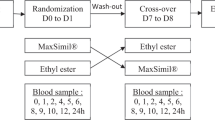Abstract
It has recently been shown that the ω3 fatty acid status in humans can be predicted by the concentration of eicosapentaenoic (EPA) and docosahexaenoic (DHA) acids in plasma phospholipids [Bjerve, K.S., Brubakk, A.M., Fougner, K.J., Johnsen, H., Midjthell, K., and Vik, T. (1993)Am. J. Clin. Nutr., in press]. In countries with low intake of ω3 fatty acids, the level of EPA in plasma phospholipids is often only about one-fifth the concentration of DHA. The purpose of this study was to investigate whether this difference in the concentration of these two fatty acids was due to a selective loss of EPA relative to DHA or to a lower dietary intake of EPA. Seven female volunteers ingested four grams of MaxEPA daily for 2 wk and in the following 4 wk they ate a diet almost completely devoid of the long-chain ω3 fatty acids. The concentrations of the ω3 fatty acids in the plasma cholesteryl esters, triglycerides and phospholipids and the high density lipoprotein phospholipids were examined at weekly intervals throughout the study. There was a more rapid rise in the concentration of EPA than in DHA levels in the supplementation period in all lipid fractions, but there was a disproportionate rise in DHA relative to EPA in the plasma lipids compared with the ratio in the supplement. In the depletion phase there was a rapid disappearance of EPA from all fractions, such that pre-trial levels were reached by one week post-supplementation. The disappearance of DHA was slower, particularly for the plasma phospholipids: at 4 wk post-supplementation, the DHA concentration in this fraction was still 40% above the pre-trial value. It is suggested that the low plasma EPA values relative to DHA are the result of increased β-oxidation of EPA and/or low dietary intake, rather than a rapid conversion of EPA to DHA. One practical result of this experiment is that, compared with DHA, the maintenance of increased EPA levels in plasma (and therefore tissues) would require constant inputs of EPA due to its more rapid loss from the plasma.
Similar content being viewed by others
Abbreviations
- CE:
-
cholesteryl esters
- DHA:
-
docosahexaenoic acid (22∶6ω3)
- DPA:
-
docosapentaenoic acid (22∶5ω3)
- EPA:
-
eicosapentaenoic acid (20∶5ω3)
- GLC:
-
gas-liquid chromatography
- HDL:
-
high density lipoproteins
- LCP:
-
long-chain polyunsaturated fatty acids
- LDL:
-
low density lipoproteins
- PL:
-
phospholipid
- PUFA:
-
polyunsaturated fatty acids
- TG:
-
triglycerides
References
Budowski, P. (1988)Wld. Rev. Nutr. Diet. 57, 214–274.
Kinsella, J.E., Lokesh, B., and Stone, R.A. (1990)Am. J. Clin. Nutr. 52, 1–28.
Neuringer, M., Anderson, G.J., and Connor, W.E. (1988)Ann. Rev. Nutr. 8, 517–541.
Dyerberg, J., and Jorgensen, K.A. (1982)Prog. Lipid Res. 21, 255–269.
Simopoulos, A.P. (1989)J. Nutr. 119, 521–528.
Adam, O. (1989) inDietary ω6 and ω3 Fatty Acids. Biological Effects and Nutritional Essentiality (Galli, C., and Simopoulos, A.P., eds.) pp. 33–42, Plenum Press, New York.
Hunter, J.E. (1990)Am. J. Clin. Nutr. 51, 809–814.
Bjerve, K.S., Brubakk, A.M., Fougner, K.J., Johnsen, H., Midjthell, K., and Vik, T. (1993)Am. J. Clin. Nutr., in press.
Glatz, J.F.C., Soffers, A.E.M.F., and Katan, M.B. (1989)Am. J. Clin. Nutr. 49, 269–276.
Phinney, S.D., Odin, R.S., Johnson, S.B., and Holman, R.T. (1990)Am. J. Clin. Nutr. 51, 385–392.
Cleland, L.G., James, M.J., Neumann, M.A., D'Angelo, M., and Gibson, R.A. (1992)Am. J. Clin. Nutr. 55, 395–399.
Brown, A.J., Pang, E., and Roberts, D.C.K. (1991)Prostaglandins Leukotrienes and Essential Fatty Acids 44, 103–106.
Sinclair, A.J., O'Dea, K., Dunstan, G., Ireland, P.D., and Niall, M. (1987)Lipids 22, 523–529.
Sinclair, A.J., and O'Dea, K. (1990) inReducing Fat in Meat Animals (Wood, J.D., and Fisher, A.V., eds.) pp. 1–47, Elsevier, New York.
Sinclair, A.J., and O'Dea, K. (1987)Food Australia 39, 232–233.
Sinclair, A.J., McLean, J.G., and Monger, E.A. (1979)Lipids 14, 932–936.
Radack, K.L., Deck, C.C., and Huster, G.A. (1990)Am. J. Clin. Nutr. 51, 599–605.
Bronsgeest-Schoute, H.C., van Gent, C.M., Luten, J.B., and Ruiter, A. (1981)Am. J. Clin. Nutr. 34, 1752–1757.
Mori, T.A., Codde, J.P., Vandongen, R., and Beilin, L.J. (1987)Lipids 22, 744–750.
Brown, A.J., Pang, E., and Roberts, D.C. (1991)Am. J. Clin. Nutr. 54, 668–673.
Nelson, G.J., and Ackman, R.G. (1988)Lipids 23, 1005–1014.
Chernenko, G.A., Barrowman, J.A., Kean, K.T., Herzberg, G.R., and Keough, K.M.W. (1989)Biochim. Biophys. Acta 1004, 95–102.
Lin, D.S., and Connor, W.E. (1990)Am. J. Clin. Nutr. 51, 535–539.
Sheppard, K., and Herzberg, G.R. (1992)Nutr. Res. 12, 1405–1418.
Herzberg, G.R., Skinner, C., and Levy, R. (1992) inThird International Conference on Essential Fatty Acids and Eicosanoids, Adelaide, Australia, Poster 31.
Gavino, G.R., and Gavino, V. (1991)Lipids 26, 266–270.
Phinney, S.D., Tang, A.B., Johnson, S.B., and Holman, R.T. (1990)Lipids 25, 798–806.
Gronn, M., Christensen, E., Hagve, T.A., and Christophersen, B.O. (1992)Biochim. Biophys. Acta 1125, 35–43.
Zhang, Z.J., Wilcox, H.G., Elam, M.B., Castellani, L.W., and Heimberg, M. (1991)Lipids 26, 504–511.
Corner, E.J., Bruce, V.M., and McDonald, B.E. (1990)Lipids 25, 598–601.
Emken, E.A., Adlof, R.O., Rohwedder, W.K., and Gulley, R.M. (1993) inEssential Fatty Acids and Eicosanoids (Sinclair, A.J., and Gibson, R.A., eds.) pp. 23–25, AOCS Press, Champaign.
Sinclair, A.J., Dunstan, G.A., Naughton, J.M., Sanigorski, A.J., and O'Dea, K. (1992)Aust. J. Nutr. Dietet. 49, 77–83.
Author information
Authors and Affiliations
About this article
Cite this article
Hodge, J., Sanders, K. & Sinclair, A.J. Differential utilization of eicosapentaenoic acid and docosahexaenoic acid in human plasma. Lipids 28, 525–531 (1993). https://doi.org/10.1007/BF02536084
Received:
Revised:
Accepted:
Issue Date:
DOI: https://doi.org/10.1007/BF02536084




